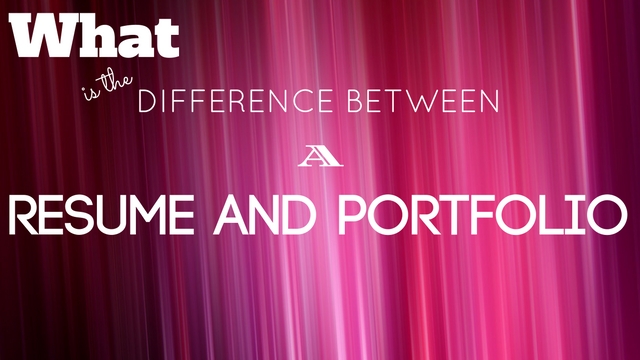In the midst of a competitive job world, many people are still wandering about with a piece of paper which they do not know much about. For them, cv, resume, and portfolio all sound the same thing.
In today’s article, we will be differentiating between resume and portfolio. What do they stand for, how they use, on which occasion they use, functional difference between the two and why one should choose over the other and on which occasion should you choose a resume or a portfolio. So let us begin.

What is a Resume? – It’s History:
Nowadays a lot of jobs are available and unfortunately, there are lots of applicant for a single job position. So how do you screen those few candidates who will be fit for the job? The answer is with the help of an effective resume.
Unlike a curriculum vitae which is too long to be readily skimmable, a resume allows a recruiter to go through the candidate’s information and make a screening process to select the right candidate in the shortest time possible.
Resume, being in precise format, help to fast forward the recruitment process. But generally, a resume stands to serve following solution.
- Originating from the French language, resume in simple English words stands for the summary. A job resume summary is basically the compressed version of all your skills, talents, achievements, and any other piece of information that is worth mentioning. You can also say that your resume is a short version of your cv. Although we will not be discussing CV or resume but still a comparison is necessary to make sure that you get to understand resume very well and how it is different from the portfolio.
- If your CV represents all of your life’s accomplishments then your resume represents your CV in a shortest and attractive manner.
- We can also say that your resume is like an invitation card where you get to introduce yourself to the world in a precise and time-saving manner. Your resume holds the key to the world of opportunities and it is through your resume that you can showcase and create a brand for yourself.
- You do not necessarily need to brag about everything that you have done, but you can make use of certain resume tips and tricks that will make you a brand, something which every company would like to recruit. A carefully crafted resume can indeed help you in landing a great job without much effort on your part.
- A resume generally uses when you want to brief about your experiences and skills in recent years. Everything is written in reverse chronological order to emphasize the recent work or project that you undertook. This type of resume format is quite useful in industries where the recruiters are more interested in your working experiences rather than your academic qualification and the courses that you attended. What matters the most is the result and outcome that you have achieved and therefore, it is essential that you use your academic resume as a weapon to brand yourself as a valuable asset to the company.
- Usually, your resume for job will contain information about your recent projects that you undertook along with your basic personal information like your name, contact information, and brief information about your hobbies and other stuff that will provide the reader with an overall idea about you as a candidate for the job and how well will you fit in the organization. So it is very important that you make sure that your work resume is carefully craft in accordance to the need of the company as your resume is all about selling your service to the company and you need to make sure that recruiting employee gets convince as to why he or she should recruit you.
- Referring to the previously mention point, it is important to emphasize the importance of a customize or tailor-made resume. Many people make the mistake of using the generalized version of a resume when applying for jobs at different positions.
- One should clearly understand that resume not only speaks about you as a person but it also speaks in volume as to how relevant you are to the company. You want to make sure the recruiter gets the idea as for why you are the best among the rest and how you are the best candidate for the given position. So make sure that your resume tailor-made in accordance to the need of the position.
- Resume finds a huge application in an industry where people are more interested in relevant work experience rather than learning about your past. It generally uses by people who are currently seeking a new job and have an ample amount of experience in that field. You need to keep certain points in mind while creating your perfect resume.
- It must contain keywords that describe the requirement of the job and make sure that all relevant experiences put in the resume while unnecessary information keeps out from the resume. Relevance is the key to success.
- Every company wants to recruit someone who is not only fit for the job but also for other social and cultural activities, therefore, you must include other information like your hobbies and other activities that make you an all-rounder person. You do not necessarily need to be excellent in your hobby but it should reflect that you possess other skills and you can be considered as an expandable candidate.
What is a Portfolio? – It’s History:
A resume serves a great purpose when it comes to providing a general impression about your life and your current work experiences. But what if someone really wants to assess your work in real-time.
In other words, how does your work really looks and feels like and how good it is in terms of efficiency and achieving the desired outcomes. Or if, someone wants to learn more in-depth about your work in action how it is implemented and how does it affect in real-world situation outcome.
In those scenarios, we make use of work portfolios in order to fulfill this shortcoming of resume or rather to compliment with a resume.
- The word portfolio derives from the Italian word portfolio where Porta means to carry and Foglio means leaf or paper. We can translate in simple English as a collection of samples that represent your work or activity.
- In proper words, the job portfolio is a collection of samples of your work or activities which is shown to a prospective employer or recruiter in order to showcase your work in action. By using a portfolio, a recruiter can get to see and testify your talent. This adds a tangible aspect to your work, thereby giving a clearer picture to your recruiter about what type of work you do, how is the quality of your work.
- Portfolio in many ways is similar to a resume. Like, resume you need to keep your portfolio up to date and relevant with time. The portfolio used in case your recruiters more interest to know about your skills rather than your academic qualification which is similar to resume in nature.
- You do need to make sure that the portfolio reflects your recent works so that the prospective employer can understand the current status and quality of your work which is again similar to a resume. The portfolio also needs to design in such a way that it persuades the viewer to proceed further and take a deeper look at your work.
- The main characteristic where it differs from your general resume is the tangibility factor. While in a resume you can add what type of work you have done or you are currently pursuing, there is no sure shot way to testify them in an interview scenario. But with portfolio, the recruiter gets to see, feel, assess the quality of your work and make a better decision. This gives an added advantage to you as your recruiter can make a better judgment which is free from any biases or any absurd assumptions.
- In case you have some great masterpieces, then the portfolio is the best tool to brand your best work and impress your interviewer.
- The field where the portfolio generally uses is photography, artistry jobs, and design makers. Although, it is not that it cannot be used in other fields. Mostly, in artistry and visual field, where the mere description of your work in simple words is not enough to give the exact picture of your performance, a portfolio is employed to learn the exact nature of your masterpieces and assess the true quality of your work.
- In such cases, it is rather convenient to use samples of your work which can certainly provide the viewer with accurate information about your work experiences and skills that have been used in creating your masterpieces.
- With the increase in demand of people who not only have theoretical knowledge but can also translate them into reality, who are capable of bridging the gap between academics studies and real-world application, many companies have started to use the portfolio to assess a candidates caliber. Not only in the audio and visual world, but the portfolio uses in computer coding, writing content, and other industrial jobs where a sample of your work will make more sense to the recruiter than just a brief description of words. Other than that, a portfolio is also useful in situations where you want to impress your interview with your work and create your own brand.
Resume And Portfolio: Differences
- A resume is a type of summary that use to describe your skills, talent, and experiences in a compact version. It generally describes in one or two pages long. It mostly uses in the industry where the people are more interested in your work experiences. Usually described in words you can make use of numbers which can help to quantify your work. In a resume, the focus is more on the outcomes that you have achieved rather than passive knowledge.
- It is more like an invitation card which you use for the first-time impression.
- While, in the portfolio, you make a collection of your sample works which gives a tangible aspect to your work experience. It is helpful in those situations where the mere description of your work does not give a proper idea about your work. A portfolio, unlike a resume, consists of images, vectors and other pictures that make it much more perceptive to the viewer and helps them to evaluate your work in action.
- One can also make use of online portfolio format to create a more vivid and fulfilling gallery of work under different categories.
- While preparing your portfolio you should keep certain points in mind. The portfolio represents the best pieces of your work, so you need to make sure that you only select those samples which represent the best use of your skill. Make sure that your pictures are wide and vivid. Description of each work should be precise and to the point.
- In no way should your work be inconsistent in format. A portfolio following a common theme or objectives strives to make a greater impact than a random collection of the sample. If you wish, you can make an online portfolio which provides you with a great amount of flexibility in terms of editing and customization.
When you combine your resume with your portfolio then it serves as the best way to get your desired job.
With many similarities like their nature of relevance with time, customized according to the type of job you are applying, and focusing more on the functional aspect of your life rather than your academics, makes them the best tool for analyzing a candidate.
They do differ in many manners which give a candidate an added advantage to using them in a combined manner. If they present in a proper manner, both of them can serve well in complementing each other, thereby increasing the chances of landing a job.







































